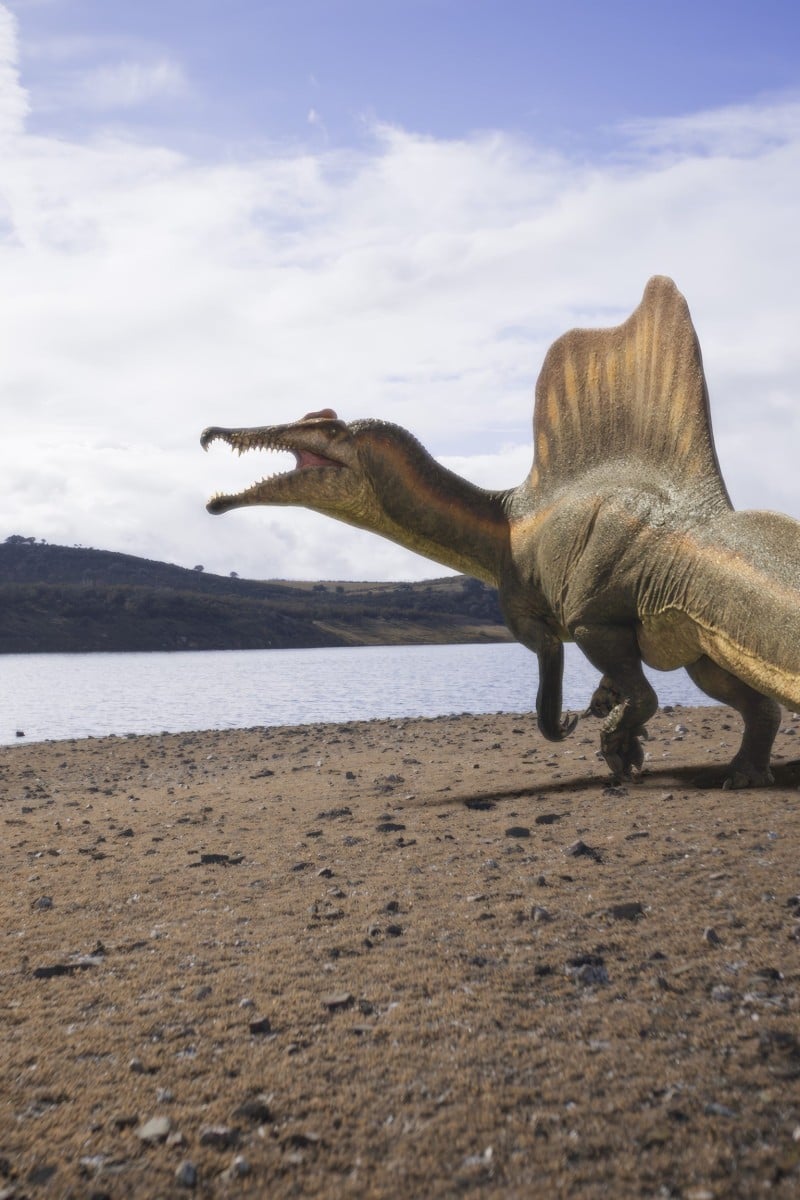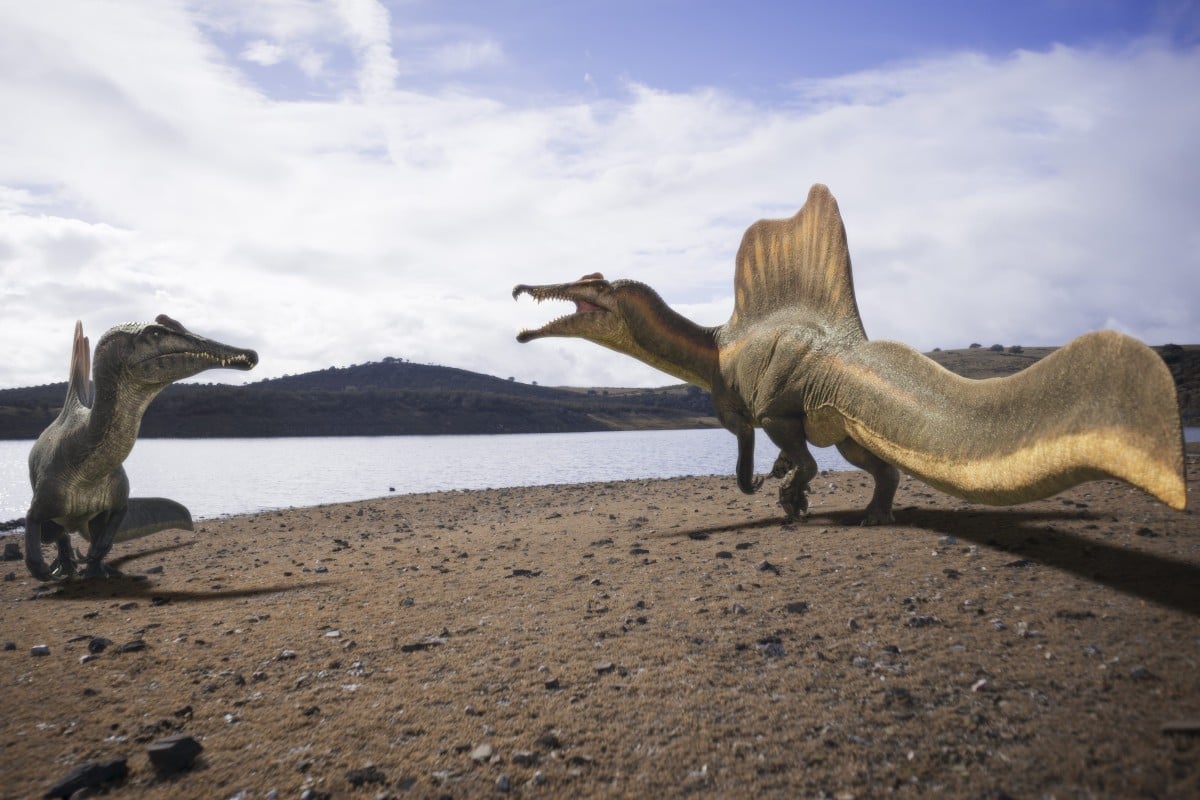
Study Buddy (Challenger): ‘Walking with Dinosaurs’ returns with more science, fossils and stories
This page is for students who want to take their reading comprehension to the next level with difficult vocabulary and questions to test their inference skills
 In the new ‘Walking with Dinosaurs’ revival, dinosaurs are given personalities and names. Here, Sobek the Spinosaurus (right) takes on a rival. Photo: BBC
In the new ‘Walking with Dinosaurs’ revival, dinosaurs are given personalities and names. Here, Sobek the Spinosaurus (right) takes on a rival. Photo: BBCContent provided by British Council
Read the following text, and answer questions 1–9 below:
[1] In 1999, the BBC unleashed what it called “one of [its] most beloved factual shows”, Walking with Dinosaurs. Now, after a surprisingly long interlude, comes a six-part continuation and celebration of animals that were always much more than their typical film portrayals. The 2025 series with the same name is not afraid to show the cuddly side of the “terrible lizards” – with a touch of unashamed anthropomorphism (giving an animal or object human characteristics) by naming the beasts and imagining their families’ lives.
[2] “We wanted to tell stories of well-rounded creatures that didn’t just bite things all day. They were parents, they faced challenges and weren’t always the apex (top) kings of their environments,” said Thomas Scott, head of development at BBC Studios Science Unit. “So we wanted stories where you rooted for them, feared them or loved them; where you felt a complete set of emotions. Just like when you watch documentaries about big cats in Africa, once you’ve seen their struggles, you want them to make that kill.”
[3] Dr Nizar Ibrahim, senior lecturer in palaeontology at the University of Portsmouth, in England, said: “One hopes the series will encourage a broader interest in fossils because they’re an amazing window into ‘deep time’. Many of the problems we are facing – [such as] change in climate and sea level, biodiversity loss, extinction and overfishing – you can only really understand if you have a deep-time perspective.”
[4] “In Walking with Dinosaurs,” he added, “we see reconstructions of our planet tens of millions of years ago. And the only reason we know there was a mass extinction, for example, is because of palaeontology. We might be in the middle of one now, so the series is a gateway to this important deep-time view.”
[5] The series uncovers the lives of six mighty dinosaurs. One is Sobek, a Spinosaurus that lived 100 million years ago, in the late Cretaceous period. At the time, Africa and South America had recently divorced, and the future Sahara desert was a forested river region. We find Sobek deeply, loudly asleep in a shady grove.
[6] Sobek – “dad looking after the kids”, as Scott called him – is the supervisor of a nursery of “babies”. He is responsible, like some modern bird species, for all parental duties. Size matters, and the intimidating Sobek shepherds his juvenile flock towards a watery hunting ground. But for the flock and Sobek – even at 11 metres long with a permanently upright, spiny “sail” along his back – the journey is still perilous.
[7] Contemporary natural history shows usually have an admirable conservationist (protecting the environment and wildlife) agenda. But what is the aim of a series dealing in long-departed flying reptiles, antique fish and terrestrial terrors brought back to life by special effects? “We want people to watch the show as a piece of storytelling, but it’s also an opportunity to understand [palaeontology’s] scientific process,” Scott said.
Source: South China Morning Post, May 25
Questions
1. Based on your understanding of paragraph 1, what might be different and unexpected about the Walking with Dinosaurs (2025) series compared to other nature shows?
2. In paragraph 1, an unusual choice the creators made was to …
A. have dinosaurs interact with other prehistoric mammals.
B. invent entirely new dinosaur species.
C. give names and fictitious family lives to the dinosaurs.
D. promote a specific theory about dinosaur evolution.
3. The phrase “didn’t just bite things all day” in paragraph 2 suggests that most depictions of dinosaurs often …
A. show them as docile herbivores.
B. focus predominantly on their predatory behaviour.
C. present them as intelligent problem-solvers.
D. highlight their complex social structures.
4. Based on your understanding of paragraph 2, what does the phrase “you want them to make that kill” about big cats imply about how the creators want viewers to feel about the dinosaurs’ struggles?
5. What is the value of studying fossils and deep time, according to Dr Nizar Ibrahim in paragraph 3?
6. Which of the following best describes the geological state of Africa and South America during Sobek’s time, according to paragraph 5?
A. They were a single supercontinent.
B. They were beginning to merge.
C. They had recently separated.
D. none of the above
7. What parallel does paragraph 6 draw between Sobek and some modern bird species?
8. Find a word in paragraph 6 that indicates Sobek’s large physical stature.
9. What is the goal of Walking with Dinosaurs (2025) according to paragraph 7?
Answers
1. The new show is not afraid to show the cuddly side of dinosaurs, which is different to their typical portrayal as ferocious creatures. It gives them names and imagines their families’ lives. (accept all similar answers)
2. C
3. B
4. The show’s creators want viewers to become invested in the dinosaurs and root for them through their struggles, even if those struggles are seen as struggles, even if those struggles are seen as disturbing, such as hunting. (accept all reasonable answers)
5. Studying fossils and understanding deep time is crucial for understanding and addressing current global issues, such as climate change, rising sea levels and biodiversity loss.
6. C
7. Some modern bird species also have a male responsible for all parental duties.
8. intimidating
9. to help viewers understand palaeontology’s scientific process
